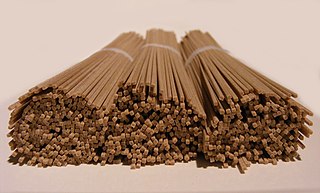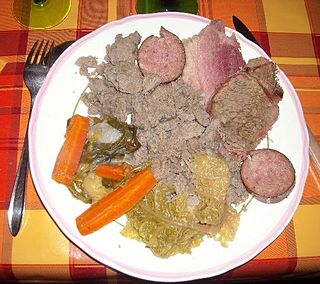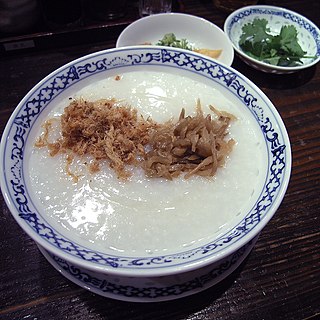| Type | Porridge |
|---|---|
| Place of origin | Netherlands |
| Main ingredients | Buckwheat, bacon, syrup |
Stip is a regional dish in the Dutch provinces of Groningen, Drenthe, and Overijssel. It is served as buckwheat porridge with a hole containing fried bacon and a big spoonful of syrup. [1]
The traditional way to eat this dish follows two steps. First, a bite from the outside of the dish is dipped into the central hole with syrup. This is continued until the edge of the hole is breached. After the breach, the dish is mixed and continued until finished. Because of this playful eating style, the dish is popular among children.
The name stip is derived of the regional word Stippen which means to dip into something.
Stip is also referred to as; stip-in-t-gat, potstroop and luie wievenkost. This last name translates into lazy wife's food. It refers to the ease with which this dish is made. The dish is prepared by boiling the milk, adding the wheat, and letting it sit.

Korean cuisine has evolved through centuries of social and political change. Originating from ancient agricultural and nomadic traditions in Korea and southern Manchuria, Korean cuisine reflects a complex interaction of the natural environment and different cultural trends.

Porridge is a food made by heating or boiling ground, crushed or chopped starchy plants, typically grain, in milk or water. It is often cooked or served with added flavourings such as sugar, honey, (dried) fruit or syrup to make a sweet cereal, or it can be mixed with spices, meat or vegetables to make a savoury dish. It is usually served hot in a bowl, depending on its consistency. Oat porridge, or oatmeal, is one of the most common types of porridge. Gruel is a thinner version of porridge.

Cereal, formally termed breakfast cereal, is a traditional breakfast food made from processed cereal grains. It is traditionally eaten as part of breakfast, or a snack food, primarily in Western societies.

Soba is a thin Japanese noodle made from buckwheat. The noodles are served either chilled with a dipping sauce, or hot in a noodle soup. The variety Nagano soba includes wheat flour.

Baked beans is a dish traditionally containing white beans that are parboiled and then, in the US, baked in sauce at low temperature for a lengthy period. In the United Kingdom, the dish is sometimes baked, but usually stewed in sauce. Canned baked beans are not baked, but are cooked through a steam process.

Russian cuisine is a collection of the different dishes and cooking traditions of the Russian people as well as a list of culinary products popular in Russia, with most names being known since pre-Soviet times, coming from all kinds of social circles.

Rice pudding is a dish made from rice mixed with water or milk and other ingredients such as cinnamon, vanilla and raisins.

Groats are the hulled kernels of various cereal grains, such as oat, wheat, rye, and barley. Groats are whole grains that include the cereal germ and fiber-rich bran portion of the grain, as well as the endosperm.

In English, kasha usually refers to pseudocereal buckwheat or its culinary preparations. In various East-Central and Eastern European countries, kasha can apply to any kind of cooked grain. It can be baked but most often is boiled, either in water or milk, and therefore the term coincides with the English definition of porridge, but the word can also refer to the grain before preparation, which corresponds to the definition of groats. This understanding of kasha concerns mainly Belarus (каша), the Czech Republic, Lithuania, Poland, Romania and the Republic of Moldova, Russia (каша), Slovakia, Kazakhstan, and Ukraine (каша), where the term, besides buckwheat, can apply to wheat, barley, oats, millet and rye. Kashas have been an important element of Slavic diet for at least one thousand years.

Ugali or sima is a type of stiff maize flour porridge made in Africa. Sima is sometimes made from other flours, such as millet or sorghum flour, and is sometimes mixed with cassava flour. It is cooked in boiling water or milk until it reaches a stiff or firm dough-like consistency. In 2017, the dish was added to the UNESCO Representative List of the Intangible Cultural Heritage of Humanity, one of a few foods in the list.

Soviet cuisine, the common cuisine of the Soviet Union, was formed by the integration of the various national cuisines of the Soviet Union, in the course of the formation of the Soviet people. It is characterized by a limited number of ingredients and simplified cooking. This type of cuisine was prevalent in canteens everywhere in the Soviet Union. It became an integral part of household cuisine and was used in parallel with national dishes, particularly in large cities. Generally, Soviet cuisine was shaped by Soviet eating habits and a very limited availability of ingredients in most parts of the USSR. Most dishes were simplifications of French, Russian, and Austro-Hungarian cuisines. Caucasian cuisines, particularly Georgian cuisine, contributed as well. Canteens run by the government were called stolovaya.

Matzah brei, sometimes spelled matzah brie, matzoh brei, or matzo brei, is a dish of Ashkenazi Jewish origin made from matzah fried with eggs. It is commonly eaten as a breakfast food during the Jewish holiday of Passover.
Korean regional cuisines are characterized by local specialties and distinctive styles within Korean cuisine. The divisions reflected historical boundaries of the provinces where these food and culinary traditions were preserved until modern times.

Kig ha farz is a cooked dish consisting of various meats simmered in a broth with a buckwheat flour based pudding. It is eaten traditionally in Brittany, more specifically around Léon in the region situated west from Morlaix to Brest. This dish, which is quite similar to a pot-au-feu, was once considered a dish for the poor and peasantry. The name in Breton literally means "meat and stuffing".

Congee or conjee is a type of rice porridge or gruel eaten in Asian countries. It can be eaten plain, where it is typically served with side dishes, or it can be served with ingredients such as meat, fish, seasonings and flavourings, most often savory, but sometimes sweet. It is typically served as a meal on its own, especially for breakfast or people who are ill. Names for congee are as varied as the style of its preparation, but all are made with rice cooked as a softened porridge with a larger quantity of water than other types of cooked rice like pilaf or claypot rice.

Pea soup or split pea soup is soup made typically from dried peas, such as the split pea. It is, with variations, a part of the cuisine of many cultures. It is most often greyish-green or yellow in color depending on the regional variety of peas used; all are cultivars of Pisum sativum.